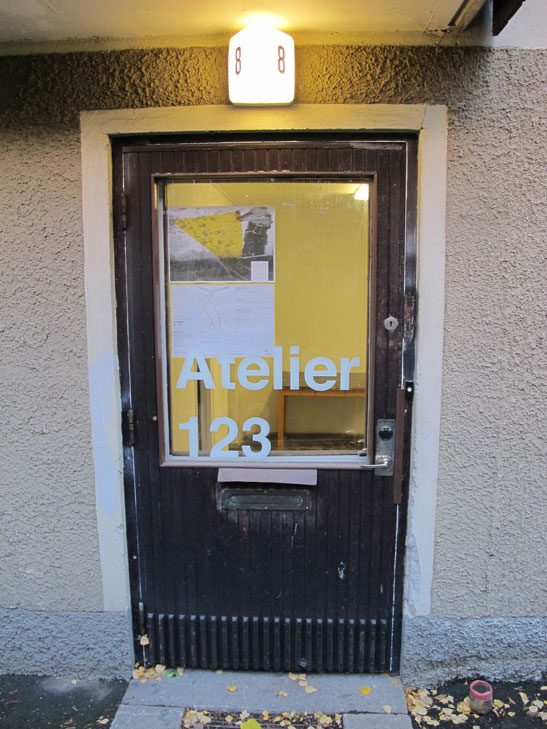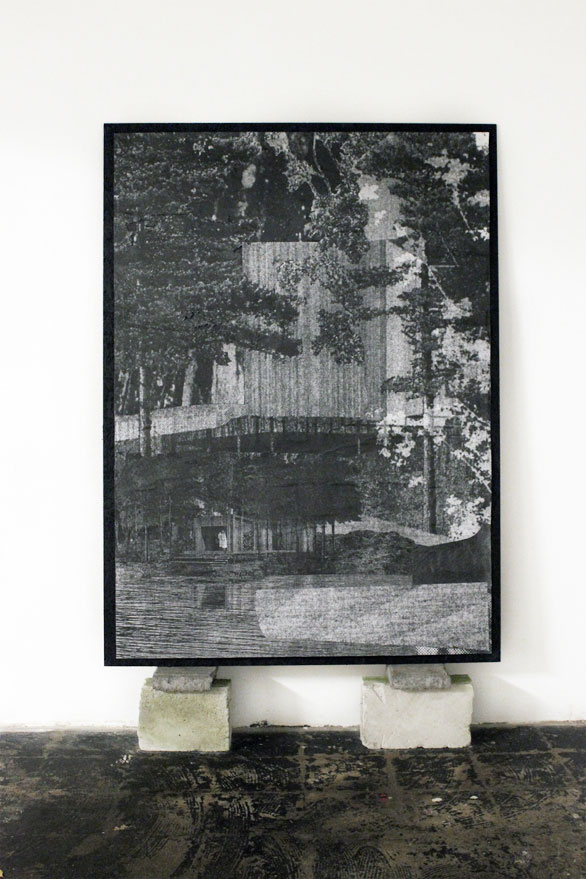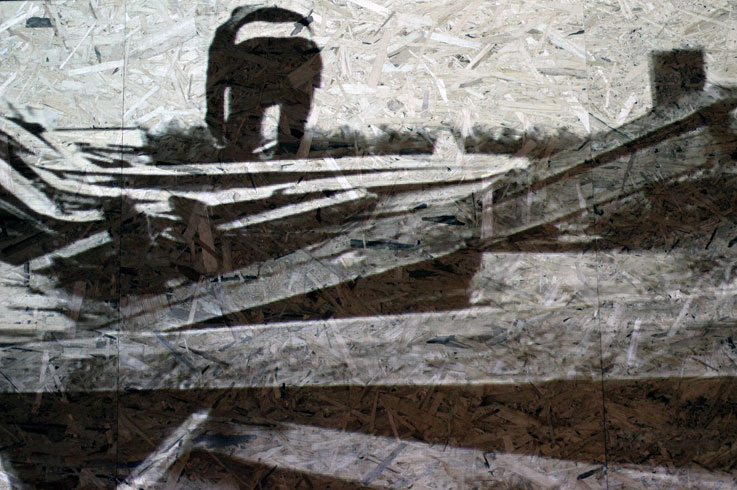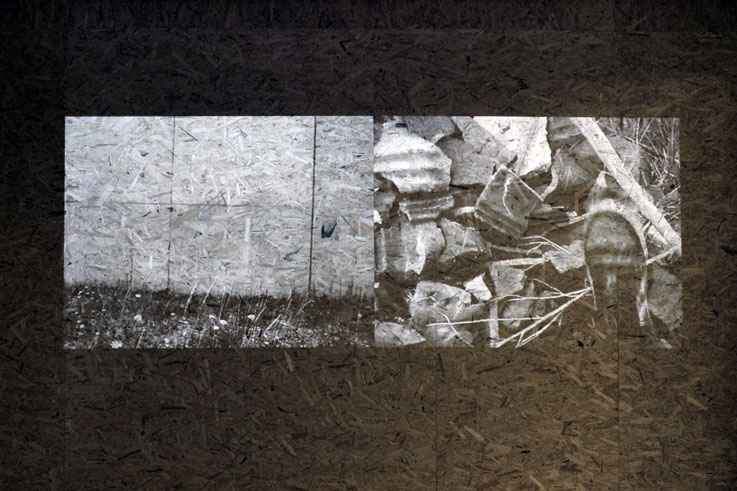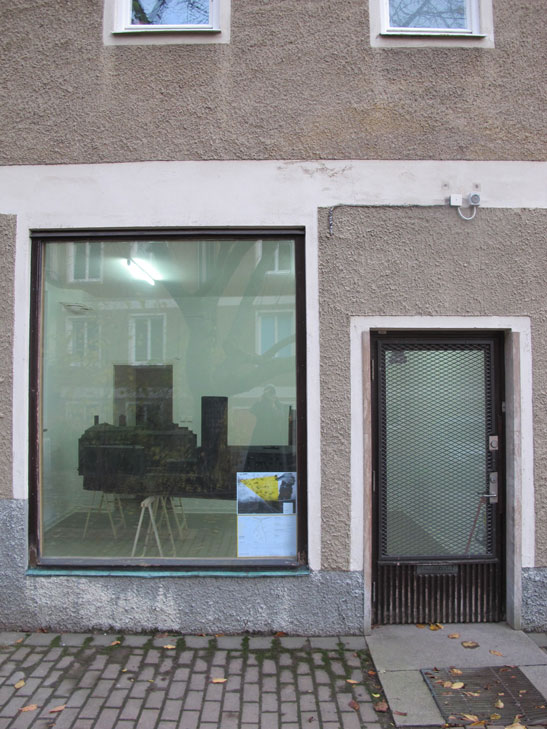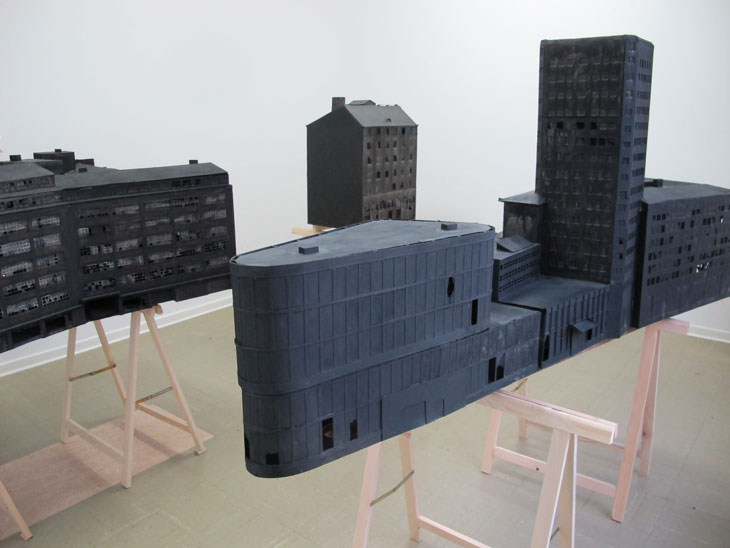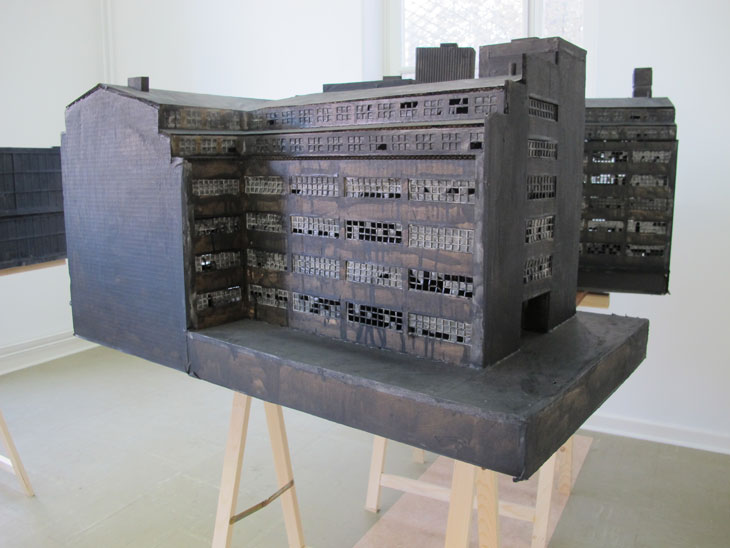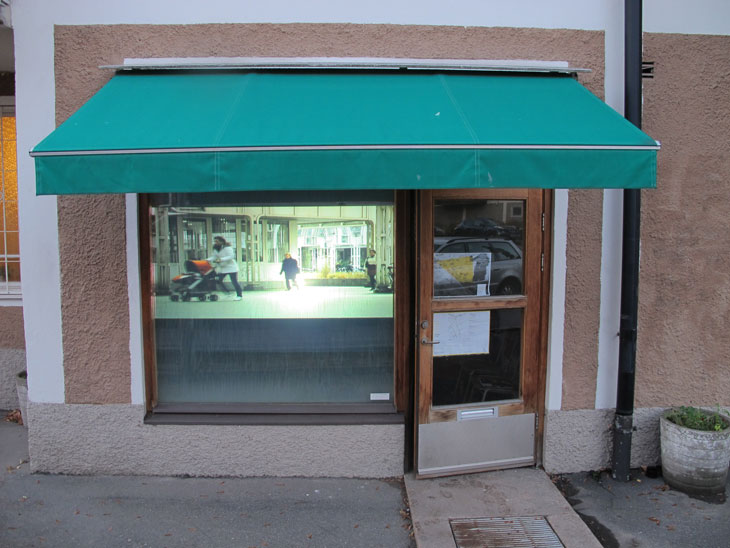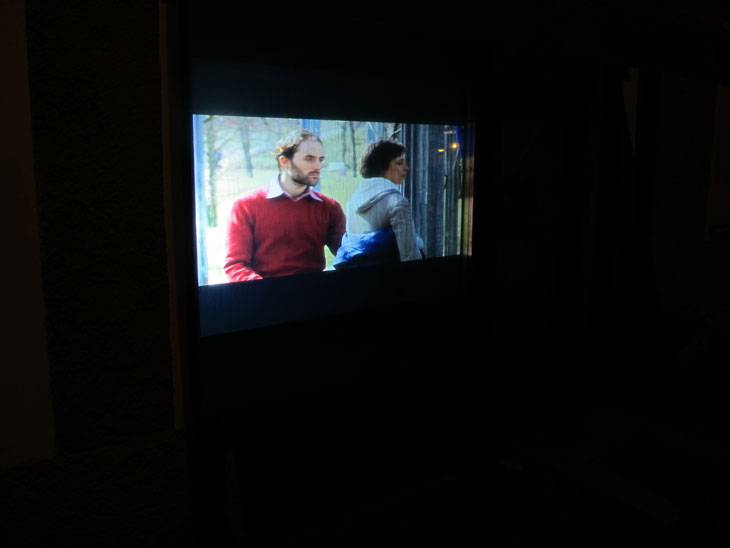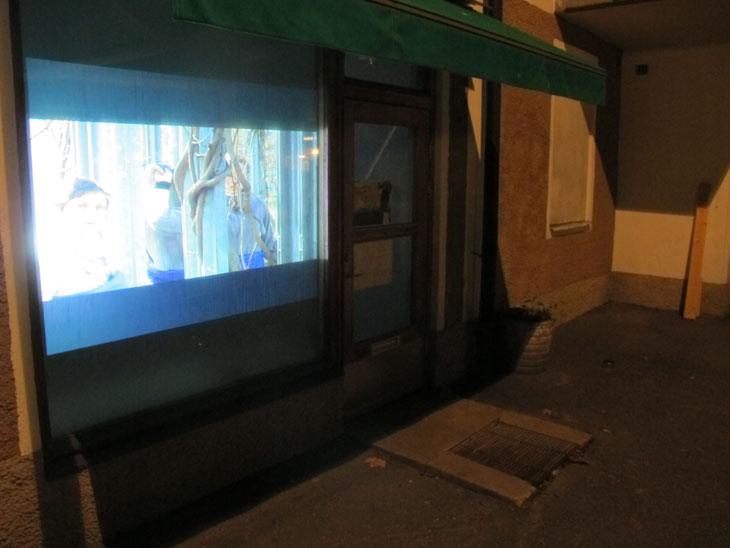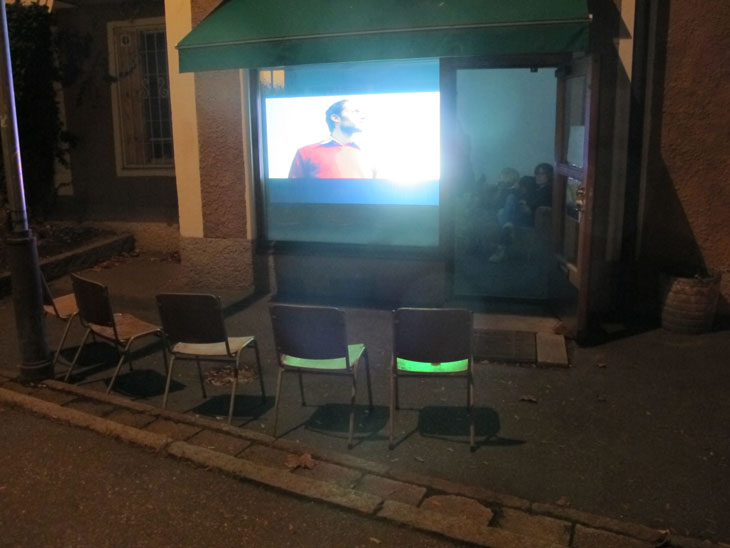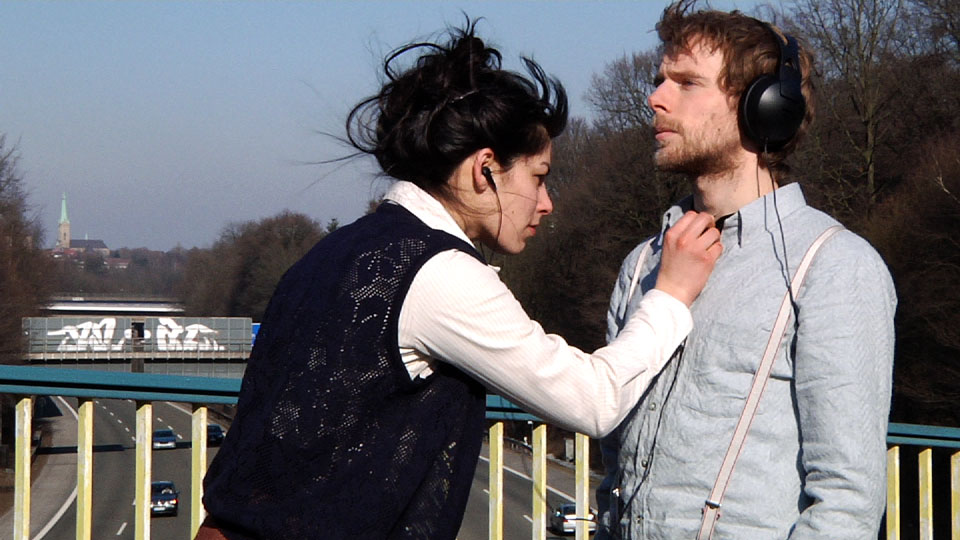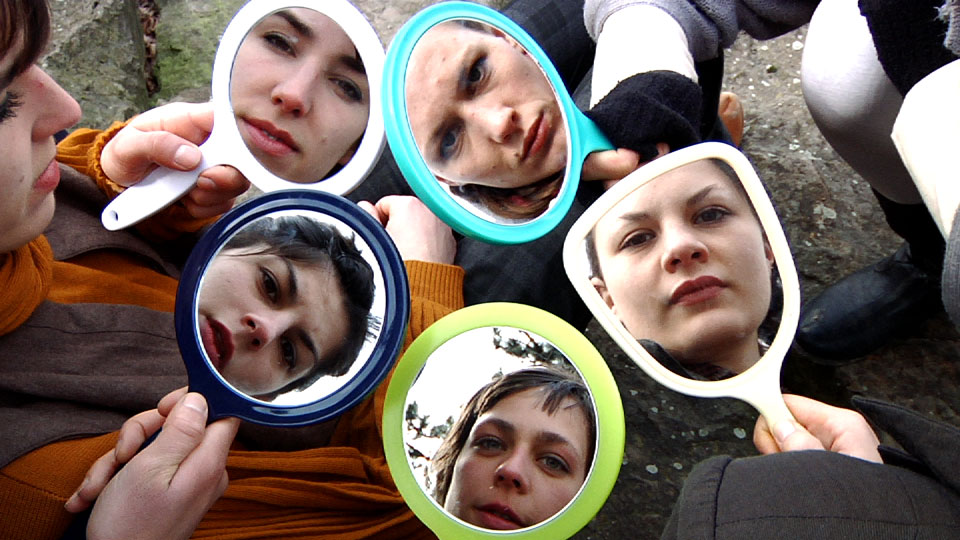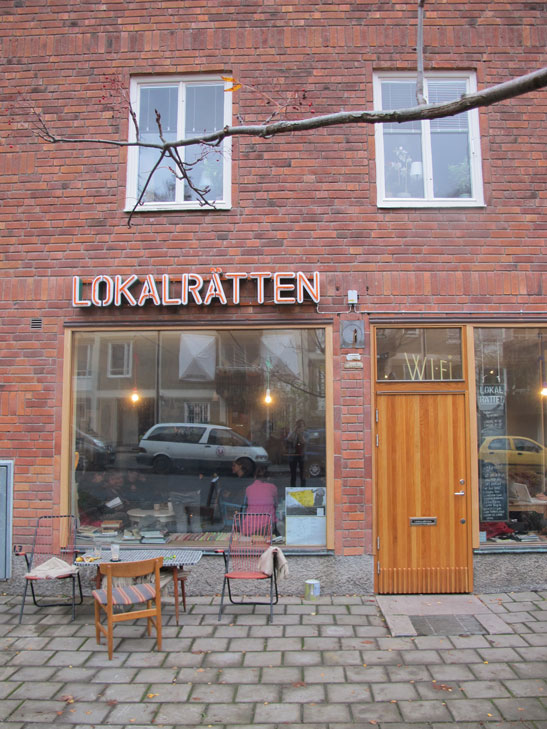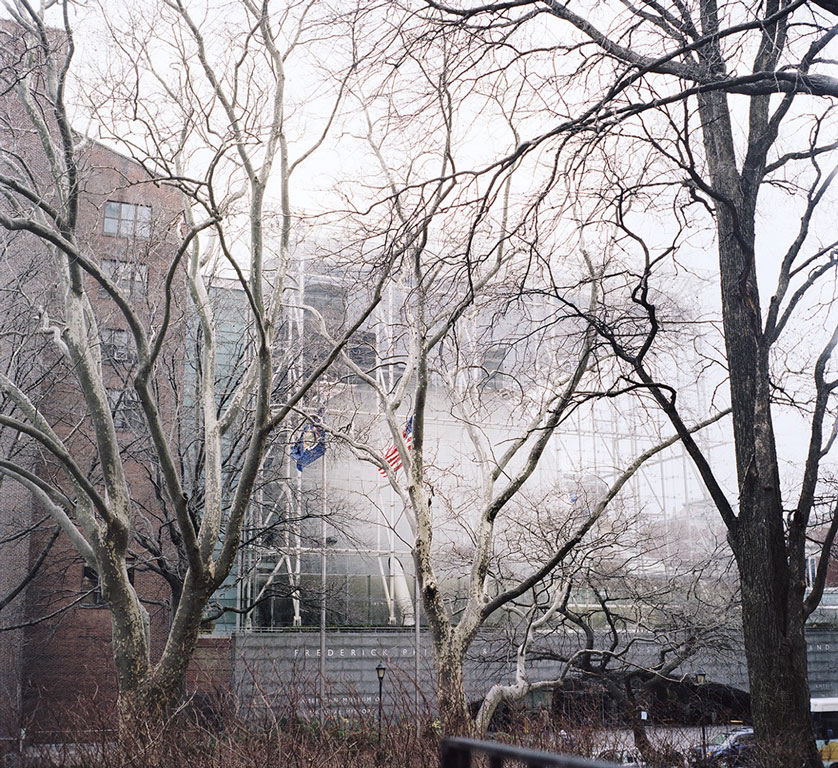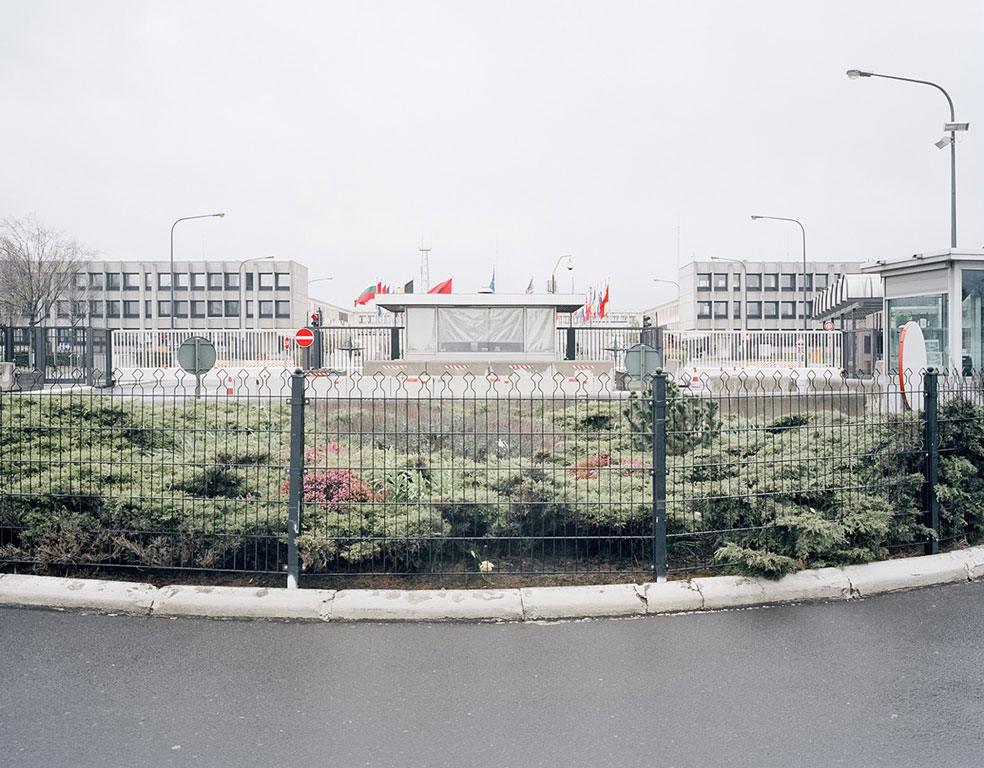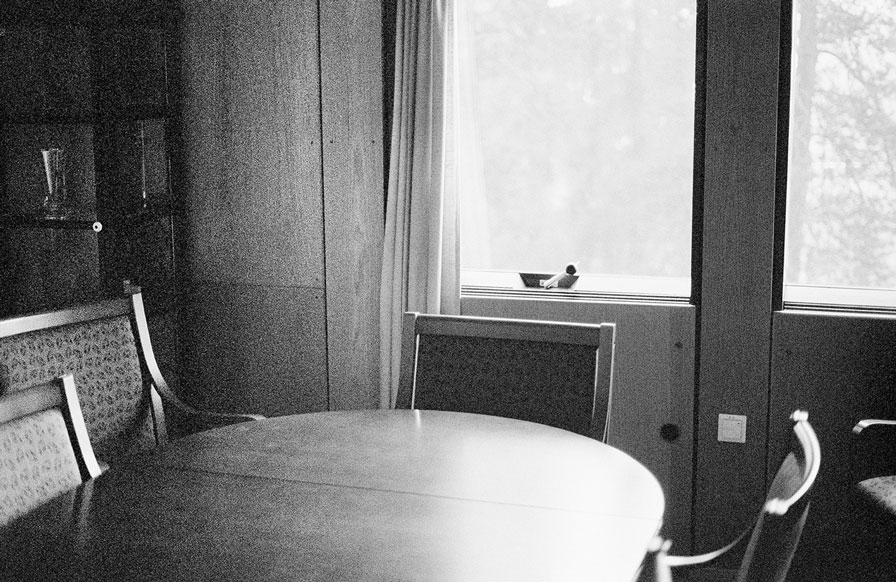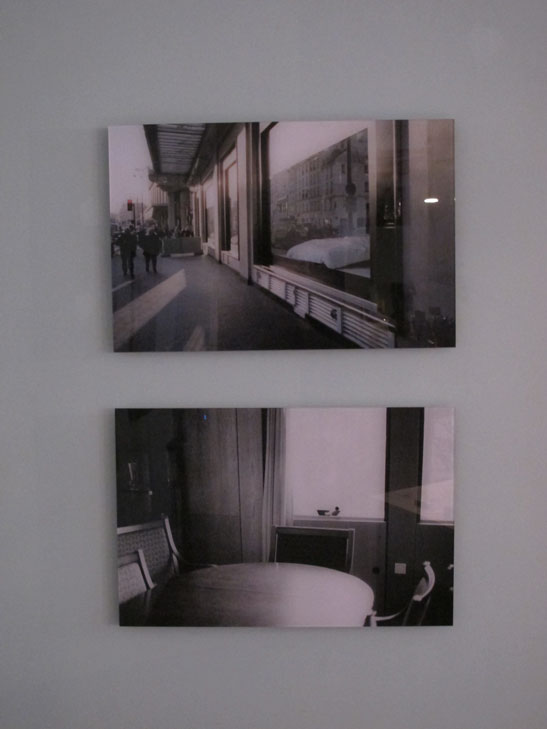Artist Interviews
-
AsbjøRN SKOU
UNSITE Interview. 04.10.13. Heather Jones / Sally Müller / Asbjørn Skou.
Much of your work seems integrate fantastic elements with very real places. Can you tell us a bit more about the interplay between reality and fiction in your work?
A:
I am very interested in how the spaces we live, think and see through works. How cultural, political and social structures are generated and fixed by an interplay between architecture, history and ideology. I have tended to claim that what I am working with is a form of spatial research, one taking its form and media through the spaces that I am investigating, be it public, institutional or pictorial space. In the work that I am currently doing, I am pendulating back and forth between site-specific physical interactions with, or investigations of, actual spaces, and a continuous image production, that, even if not always directly, feeds on the physical interactions. The reason for trying to work this way is a desire to make things that collage lived space and abstract discourse. To make things that are both concrete reflections, and allegorical expansions, of my surroundings. One of the subjects that I keep returning to, is the liminal and ambiguous spaces, the ones that either fall outside of the schema of stringent planning, or which serves as vessels and thresholds for an order outside of themselves. The spaces that we either don`t see, or which define the way we see. In focusing on this, there is generated an attention towards concepts of presences and absents, as two of the basic questions that can be asked of any space. What do we see, what does it mean and why is it so? And vice versa. But as my field of work is art, and not anthropology, sociology or philosophy – I try to frame the questions within a formal aesthetic structure. By taking things and ideas from “the real” and breaking them down into fragments and layers of fictionalization, I find that they tend to expand beyond themselves. They enter a condition of fluctuation, where the perimeter for their identity and meaning are shifted, it grants them the possibility for new constructions of explorations and meanings.All of the work that I am doing at the moment have a connection to the idea of bricollage; of taking forms, concepts, ideas and things, that are not necessarily connected, but which through their collections and combinations, either expand or circumvent one another. In the image collage work, the approach is used in one way, usually connected to a tradition of the media, and always with the intend to make something that both serves to create an image, and formulate something outside of the image. In the pseudo-documentary works, the approach of fictionalization is another. In these there is a hovering question of where the actual work lies? Is it in the original in-situ interaction with a place, or is it in the process of documenting this? Since the documentation become another way of image fabrication, I try to use a certain schema to fictionalize this documentation, giving the pictures a specific aesthetic value, framing them as only part-real. Thereby I am trying to give the viewer the possibility of doubt, as to what is going on, when and how, and whether or not it is actually going on at all.
But one of the things that combine both the image collage and the documentary images, is that while always with a fix-point in actual places, events and images, they are searching for exactly the fantastic elements that are to be found in very real places, the vague terrain between fact and fiction. A space where everything serves as allegory, and must be read as a sign. It is a semiotic and pictorial process of mythologization.
What characteristics define a place for you and how do you choose a place you would like to work with?
A:
The first is actually somewhat difficult for me to answer, as it is a very broad question. But taking a longshot, I would say that space is a thing of quantity, place is one of identity, and to add on that, site is where something is situated - belonging to something else. What I find interesting is, trying to ask what the collective definition of a place is, and why it is so. In all the stories we tell each other to define and engage society, we use the fixtures of space, place and time to make what we tell comprehensible. But at the same time we live in a “real” saturated by hyper - objects and structures. Things that expand and extends beyond these concepts. As I mentioned before I am very interested in liminal spaces, spaces that are “either or”, or not what they seem. So when I say that I try to work site-specific it is actually not altogether the truth. I am both trying to work in “This street” and “A street” at the same time. In choosing a place I would like to work with, it is usually done by its possibilities of becoming this, concrete and allegorical at the same time.In both your earlier graffiti and more recent interventions, you act on and insert things into the urban environment. Is this a violent/aggressive act, an act of collection and preservation, or the re-introduction/highlighting of the mysterios element of the cityscape?
A:
There is not one schema to how I think that the work with the city should and could function. All of the above mentioned approaches have their qualities, justification and purposes (there is a time and place for everything). I would say that I am simultaneously trying to de-, re- and construct, if nothing else, then at least my own assumptions of how stuff works. As an act of being in the world, in a specific geography and environment, as an act of producing, deconstructing and reproducing meanings and things. In specific relation to the city, I think that there is a general desire among all of us (dangerous assumption as that ever is) to make mythologies of the place and concept, simply to cope with its inherent brutality. The same could perhaps be said about history. Or any other socio-spatial construction. To make an attempt at both grasping, navigating and getting lost in concepts as complex as the city, I think a good point of departure is searching for the possible intersections of materiality and immateriality. The points in our everyday where the tangible and its production of meanings meet.What role do you take on when examining and investigating a place?
A:
I would love to say that I have a fixed gallery of personas or roles that I could apply to a give situation of space, but its not the case. I take on the role of the artist. But within that, there is a broad field of possibilities of stealing from other positions of form and subject-matter. I have done some projects where I have used anthropological terminologies and references, urbanist ideas and socio-philosophical lingo. lately I have been having this off-hand relationship with archaeology. Right now I am pretending to be a student of architecture, but this is mainly amounting to me building scale-models of ruins.You created the installation UNSITE specifically for the exhibition Let's Pretend We Live Here. Can you provide some insight to the choice of title and working method? Could you also tell us more about the connection between the video and the collage, which refer to and reflect upon each other, you show at Atelier 123?
A:
The title, UNSITE, is a contraction of the words “unearth” and “non-site”, which are both terms related to an archaeological and philosophical context. Unearth means to excavate something, but also to expose meaning, or matter, through extensive search. Non-site refers to both archaeological findings done outside of a designated field or space of research, but also to a place that doesn’t exist. The project consists of two works, a film, or films - which are a semi-fictional archaeological investigation in the periphery of urban planning and memory, and a collage, which suggest an ambiguous utopian space of past futures. I am right now, independent of this exhibition, doing several works which relates to the concept of ruins, and wanted to work with this idea of pseudo-site-specificity. The ruin as a concept holds a lot of interesting potential when discussing spatial and historical ideas. The ruin is the collapse of time into space, it is a contraction of material and history, as a dialectical image - both capable of de-mystifying and obscuring. It is a vessel for ideologies and their destruction at the same time. The ruin as such is not necessarily a fundamental other to architecture, but rather a point of dissolution, where the object undergoes a shift in meanings. At times a very interesting temporal construction, conjoining the very different temporalities of people, architecture and nature. Of cause these various potentials are always defined by the type of ruin we are discussing, but on a very abstract level, The Ruin is both spatial, temporal, and social implosion – the collapse of understood planning and order and the violent shock of vanishing materiality. But one could also choose to see this as a space embodying vagaries of utopian vision. I think that the margins of things, are a space with a radical potential for openness. One where the anchorage for our understanding of object, architecture and history is potentially shattered, and new explorations in perspective and meanings become possible. Pasts that could have been, and futures that never came to be, but not as an inspiration for restorative nostalgia, rather as a point of departure, in seeing the ruin as crevice in history, through which it is possible to break into other presents and futures.In terms of work approach, I wanted to make a film, which was both a very linear documentation of a sort of interventive research of several different actual ruin sites, but which fictionalized this documentation, in such a way, that its cause of action is both trying to “expose” the nature of these sites – through concrete investigations of their material characteristics - “unearthing the site” so to speak. At the same time, the film, and the investigation itself, is constantly obscuring the actual identity, and geographical qualities of the places investigated. Thereby turning them into allegories, or signs.
The collage was made out of a lot of different images, all taken from digitally generated plans for architecture, that was to be built. Both the actual built environment, but also people placed there to show scale, and the vegetation surrounding the houses, to place them in a geography. I processed the images in a way so that they correspond aesthetically with the film, or the other way around, so that both things have the same “collaged feeling”. They are in fact also both, film and image, built on strategies of collage, and both in a quite classical way. The image by juxtaposing fragments belonging to other contexts, the film by staging several spaces and causes of action, as if they are one place, or a linear cause of events.
The film is very concrete in its form, and the material depicted, it is all debris of the everyday objects of neglect, the remnants of built environment that tends to loose their meanings when not connected to a greater whole. It is plastic sheets, metal rods, broken drywall and concrete elements, styrofoam, insulation and cinderblocks, wood, earth and alloys – and vegetation “reclaiming” or absorbing the whole thing. There are buildings in there too, relatively recognisable structures that we usually see in the peripheries of cities, post-industrial remnants and new concrete suburbia. The person, or persons, moving through this landscape, are conducting some kind of research of it, but in a slightly panicky kind of lacklustre way, as if not quite knowing what to do with the whole thing. The protagonist sometimes seem to be searching for a way around, or perhaps out of the place, but at the same time, he is wanting to engage with it, touch it and take it apart, even disappear into its architecture (in the case of one ending of the film). And the place, or zone, seemingly has no limit, it is a continuous parade of seemingly unusable fragments and superfluous infrastructure. At a point it even seems to evaporate, like a smoke-screen. Filmed in a horribly poor quality, both utterly aestheticised, and visually unpleasant to a point where it is almost unbearable to watch.
The image collage is not necessarily thought as an opposite, or a reflection of what happens in the film, but there is a connection, beyond that of the grainy black and white aesthetic. What it depicts is to me the only kind of utopia that can exist as such, paper-architecture. It is inherently romantic, and slightly disturbing in an uncanny way. The architectural structures in the image could both be nice little boat, bath or forest houses, but with their cubic and windowless forms, they also slightly resemble bunker architecture. Somewhere to recede to. A memory of past plans and dreams, or ruins from the future.
-
Carl-Oskar Linné and Marius Moldvaer
REAL WORLD OR PLACES THAT DON`T EXIST Interview. 15.10.13. Heather Jones / Sally Müller / Carl-Oskar Linné / Marius Moldvaer.
Real World or Places that Don't Exist is a collaborative project between you, Carl-Oskar Linné and Marius Moldvaer. Can you tell us a little bit about the impetus for this project and how you came to work together?
MM: I would say that the project developed quite naturally from our joint interests. It's a natural progression of discourse. A discussion between two people that took an interesting turn and ended up in this artwork. It's our joint interest in places together with the contrasts and similarities in the way we view them.
COL: That and that we have collaborated before. We did while in school by asking each other for advice about our very different projects and by doing that numerous times we found out how our concerns are connected. We then collaborated through Gruppe 11 many times, so it is indeed natural that this project came to be when an exhibition opportunity arose a few years back.
Much of your work incorporates urban and suburban landscapes and motifs. What is it about the cityscape that interests you and how do you think about and interact with these places?
COL: For me it comes from photography. When I started photographing I dealt with those kinds of landscapes as a way to address my relationship to what I felt was around me. My actual work is not about photography, I rather use it as a method to talk about modes of speculation, loneliness, tourism or other aspects relating to sites or contexts I am in. In particular, I'm concerned with the point where the private meets the public, or the very intimate meets the political. This is easy to find in a city, and even more in the home.
MM: The cityscape, let's call it the city, for me that is where the world is created, where we interact. My fascination for the wild and nature will always be in relation to society and the city.
COL: You are talking about nature now? What you are working on right now is about wilderness, right?
MM: Yes, it is. I always think of them both at the same time, wilderness and society, the inhabited and the uninhabited. It seems like there is a constant juxtaposing of oppositions in what we do, the pendulating, the oscillating, the postmodern and the romantic, the metamodern.
COL: The romantic, not the modern?
MM: No, not necessarily, because I think the romantic occupies a great part in the modern.
COL: As a utopia, ok. I think in the book this metamodern state is most visible in the chapter about Versailles, where the first part quotes Rousseau about the natural state and then in the footnotes refer to the bulk of information about the film Marie Antoinette, listing all the sites in which the film was recorded. In this way, in each chapter there are two parts, the text and the footnotes, one part referring to the fictional and one to the factual.
Part of Real World of Places that Don't Exist involves the arbitrary translation of birth dates into geographical coordinates. What are the roles of chance and imagination in this project and your practice as a whole?
MM: Arbitrary translations... I think all language is arbitrary. We used birth dates as an example of how a place is given importance through our actions. That place had no value before we found it to be the coordinates of our birth dates.
COL: What about chance and imagination? We had to define and defend to each other how the places that we wanted to work with in this project, a place we wanted to visit or a part of a chapter that should remain, was relevant. I wouldn't describe that as doing by chance or imagination, however the investigations are not complete or final.
MM: Imagination, I'm only thinking about the four photographs from Auschwitz, the Georges Didi-Huberman book, where he says that to look at photographs you have to imagine, that is the way that the photograph is at its most powerful. Imagination, the first part is image. That is a vital thought. What are the roles of chance and imagination in your practice?
COL: In an investigation you can never be certain what you will bump into or what will trigger your work. But that is not really chance. I like the way you describe imagination. When I display images, very rarely the pictures tell the whole story, there is a lot of opportunity for imagination. By telling pieces and fragments of what is behind the image I think the imagination gets even more… Oumpf. Those pieces and fragments can place it in a bigger picture, even if they are not directly visible in the picture, much like Christopher Williams photographs.
In the project description you say that you're investigating places that, for various reasons, don't actually exist. What do you mean by this and can you describe how narratives, facades and cultural shifts come into play?
COL: We look at places differently. We started debating these sites and found very different aspects of those places. We found what could be called narratives, facades… I like to call them layers. That was the starting point, the project developed from that into intentionally looking for places that are ambivalent or difficult to define, but still well known.
MM: All of these places were strong places, the first encounter is strong, like with the NATO headquarters. It has a weight. But then you have all these layers, when you start looking at each one of them you come to a point where the physical existence of the NATO headquarters is…
COL: I think all of these places are in fact, debatable, non-places. NATO is not necessarily a place, Bon Marché is not necessarily a place, the Museum of Natural History is not necessarily a place. It's about relations to power structures, to local cultural phenomenons, personal experiences, the places in themselves become almost a by-product.
-
Jakob Krajcik
PAPPERSHUS Interview. 10.09.13. Heather Jones / Sally Müller / Jakob Krajcik.
You’ve made dystopic models of a variety of buildings including prominent galleries and museums, and elementary school, a design headquarters, a popular café, and a palace. Could you talk a little bit about the choices of buildings you chose to model? What was behind these decisions? You’ve (re)created prominent and well known buildings in a manner suggesting ruin, abandonment and decay. Is this a vision of a possible future? A hope for a different future? A warning? What ideas are behind picturing the buildings in this way? My next questions are more about process. Are these models actually to scale and if so, how did you obtain all of the architectural information? How and out of what material are they constructed?
I am deeply aware of what the ruin signals symbolically, and I have chosen to use that in my artwork. In most of the sculptures, the underlying theme is destruction. I can, through my models, act freely. I have the opportunity to act against what these buildings represent, and it is obviously a violent gesture. Then there are of course many aspects to the significance of the ruins in my work. I am almost fixated on chronology and generally work alot with my own experience of time and memory. This series of buildings is about an imagined past. The work is not necessarily a dystopian prophecy, but is probably more a question of transience. And I mean not only the physical buildings, but in equal measure the inconstancy of the institutions these buildings represent.
The series PAPPERHUS is a work in progress and the choice of buildings has grown steadily during the work. I have never followed a predetermined plan or thought up a series of specific buildings beforehand. It is indeed a series of houses, in some cases with quite obvious political undertones; looted or burnt down buildings, such as the Royal Academy of Arts or Magasin 3. If I had wanted to take a more pronounced political position, I would of course also be able to choose buildings such as the Migration Board, Government House and the Royal Palace. This attitude may be valid but also threatens to become a bit one-dimensional. In most of the works there are several reasons both for the choice of model and design. I have no personal connection to the buildings represented.
2010, I was asked by my former gallery owner Peter Bergman to create a piece for Market Art Fair in the Art Academy building at Fredsgatan in Stockholm. The work is a play with perspective. You are really in the building to consider it. And of course, it suited me perfectly to portray the Arts Academy (particularly Market Art Fair) as a ruin. The same applies to the model of the redevelopment Reina Maria in Spain which largely contributed to the ruin of the city treasury. But I have also made models such as my childhood home (from memory). These models are not really ruined, but painted black because I wanted to get a wraith-like appearance. The black then becomes more of a shadow.
The ruin has more or less been a recurring theme in my work. Ruins and remains of things that have been. It may be dead flowers in various arrangements or the remains of a bleaching exposure. I have also worked some with perceptual installations and the repetition of images, and then it's really a kind of play with memory. As a child I was in a serious fire and I "apply" the experience and memory of the incident at existing sites in my life and my surroundings. A real fire is something fatal and very traumatic, not able to be undone, and my work is a kind of way to approach the border.
I like to work with recycled materials which are worn. It is usually a question of economics. India ink, shellac and black pigments have become standard in my work as it is plentiful, fresh, fast and can be used on most materials. It is also important to seal the paper work with a varnish and shellac which works very well to clean and preserve the sculptures.
-
Silvia Ospina
NOMADEN Interview. 15.09.13. Heather Jones / Sally Müller / Silvia Ospina.
As a choreographer, you engage heavily with movement, both of bodies and through spaces/places. The title itself, NOMADEN, refers to movement and placelessness. Can you tell us a bit about the choice of title and the underlying themes of the the video?
S: Well, NOMADEN is the last of two other projects that I developed during the last few years, where I was researching about the relations between territory and identity. The other two projects were made for the stage and for NOMADEN, the plan from the beginning was to produce a film. In my other projects I was working with those relationships using the frame of my own cultural background (Colombia) and the difficulty of building an identity in a territory where we find diversity still dominated by a colonial way of thinking. This is visible in the economic and social division, the fast and forced development of modern cities, and the never ending conflict between Land - Countryside: a space where many important and precarious political situations are happening at the moment. I was very sensitive to the meaning and consequences of living in an specific territory.
My own experience and the opportunity to continue developing this subject with a varied group of people in Germany led me to develop NOMADEN, a work that explores the boundaries and limitations of movement in a territory.
There seems to be an unspoken narrative or timeline leading the work. The characters in the film seem to react adversely to the suburban/industrial cityscape and try to leave (perhaps even regress) and find a place to stop, to settle, to inhabit. When you were making NOMADEN, was there a specific goal or message that you wanted to impart to the viewer?
S: I observe a strong tension between land and city, not just because they are in contrast and opposition to each other, but because the possibility to move there, this transition or decision in our modern way of living, becomes a kind of Utopian movement. I found this tension to be a good context for the questions of the NOMADEN project.
I come from a dance background, so I believe very strongly in the expressive qualities of movement, the gesture, and the images that are created in the juxtaposition of actions, movements, and spaces. I was building NOMADEN with a lot of intuition; following the living pictures that came to me through the work with the performers. I kept from them what I considered to be a strong and sometimes untranslatable meaning. I like that! More than a specific message, I wanted to create a "lebendig" space-time for the viewer, filled with those rich images.
Was the relationship between humans, the built environment, and nature at the core of your thinking when creating this work?
S: They were the protagonist of this work. I was searching alot with the performers, and I think we found a special movement material that develops in powerful pictures together with the space and the sound. So, as I experimented with the performers, I think my intention was to explore with this film a possible commonly shared imagination about the land and the way we live on it.
The performers in the film seem to be in a state of limbo, a constant flux of movement and place. Is this feeling of in-between-ness central to the work?
The way the performers appear throughout the film is something we discovered through the process of finding the scenes and the material. How they look is dependent on your interpretation. For me, they express a state of awareness. They do not talk and this is irritating for some people… NOMADEN underlines the individual and group presence and the way that they communicate in this constellation.
There also seems to be a heavy emphasis on looking and perceiving (I'm specifically referencing the scenes with the mirrors, the flashlights, and the headphones). Would you say that human connection and engagement is another theme of NOMADEN?
S: Personally, I'm very interested in expressing other ways to connect with people. The human relations in our everyday lives are dominated by words and this is something we already all know. We could say that NOMADEN is definitely calling attention to other ways to connect and communicate with each other.









